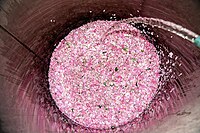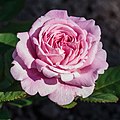Rose water
 Rose water is produced manually in Meymand city, capital of Meymand, Firuzabad, Fars, Iran | |
| Type | Flavoured water |
|---|---|
| Place of origin | Ancient Iran |
| Region or state | Asia and Europe |
| Main ingredients | Rose petals |
| Ingredients generally used | Water |
Rose water is a flavoured water made by steeping rose petals in water. Additionally, it is the hydrosol portion of the distillate of rose petals, a by-product of the production of rose oil for use in perfume. It is used to flavour food, as a component in some cosmetic and medical preparations, and for religious purposes throughout Asia and Europe. Iran accounts for 90% of the world's production.[1]
History

Since ancient times, roses have been used medicinally, nutritionally, and as a source of perfume.[2]
Rose perfumes are made from rose oil, also called attar of roses, which is a mixture of volatile essential oils obtained by steam-distilling the crushed petals of roses. Rose water is a by-product of this process.[3] The cultivation of various fragrant flowers for obtaining perfumes, including rose water, may have originated in Persia,[4][5][6] where it was known as gulāb (Middle Persian: گلاب), from gul (rose) and ab (water). The term was adopted into Medieval Greek as zoulápin.[7] The process of creating rose water through steam distillation was refined by Persian and Arab chemists in the medieval Islamic world which led to more efficient and economic uses for perfumery industries.[8] Today, Iran produces 90% of the world's rose water.[9]
Uses
This section needs additional citations for verification. (January 2020) |

Edible
It is sometimes added to lemonade, and often added to water to mask unpleasant odours and flavours found in tap water.
In South Asian cuisine, rose water is a common ingredient in sweets such as laddu, gulab jamun, and peda.[10] It is also used to flavour milk, lassi, rice pudding, and other dairy dishes.
In Malaysia and Singapore, sweet red-tinted rose water is mixed with milk, making a sweet pink drink called bandung.
American and European bakers often used rose water until the 19th century, when vanilla became popular. In Yorkshire, rose water has long been used as a flavouring for the regional specialty, Yorkshire curd tart. In Iran, it is added to tea, ice cream, cookies, and other sweets.
In Middle Eastern cuisines, rosewater is used in various dishes, especially in sweets such as Turkish delight,[11] nougat, and baklava. Marzipan has long been flavoured with rose water.[12] In Cyprus, Mahaleb's Cypriot version known as μαχαλεπί, uses rose water (ροδόσταγμα). Rose water is frequently used as a halal substitute for red wine and other alcohols in cooking.[citation needed] The Premier League offer a rose water-based beverage as an alternative for champagne when awarding Muslim players.[13] In accordance with the ban on alcohol consumption in Islamic countries, rose water is used instead of champagne on the podium of the Bahrain Grand Prix and Abu Dhabi Grand Prix.[14]
Cosmetic and medicinal use
In medieval Europe, rose water was used to wash hands at a meal table during feasts.[15] Rose water is a usual component of perfume.[16] A rose water ointment is occasionally used as an emollient, and rose water is sometimes used in cosmetics such as cold creams, toners and face wash.[16] Its anti-inflammatory properties make it a good tool against skin disorders such as Rosacea and eczema.[16]
Some people in India also use rose water as a spray applied directly to the face as a perfume and moisturizer, especially during the winter; it is often sprinkled in Indian weddings to welcome guests.
Religious uses
Rose water is used in the religious ceremonies of Hinduism,[10] Islam,[10] Christianity (in the Eastern Orthodox Church),[17] Zoroastrianism, and Baháʼí Faith (in Kitab-i-Aqdas 1:76).
Composition
Depending on the origin and manufacturing method, rose water is obtained from the sepals and petals of Rosa × damascena through steam distillation. The following monoterpenoid and alkane components can be identified with gas chromatography: mostly citronellol, nonadecane, geraniol and phenyl ethyl alcohol, and also henicosane, 9-nonadecen, eicosane, linalool, citronellyl acetate, methyleugenol, heptadecane, pentadecane, docosane, nerol, disiloxane, octadecane, and pentacosane. Usually, phenylethyl alcohol is responsible for the typical odour of rose water but is not always present in rose water products.[18]
Images
See also
References
- ^ https://plus.google.com/113403756129291503583 (2019-06-15). "Iran Meets 90% of Global Rosewater Demand". Financial Tribune. Retrieved 2021-04-16.
{{cite web}}:|last=has generic name (help); External link in|last= - ^ "GOLĀB". iranicaonline.org. Retrieved 2021-03-24.
- ^ Adamson, Melitta Weiss (2004-01-01). Food in Medieval Times. p. 29. ISBN 9780313321474.
- ^ Adamson, Melitta Weiss (2004). Food in Medieval Times. Greenwood Publishing Group. p. 29. ISBN 978-0-313-32147-4.
Rose petals were already used in Persian cookery to perfume and flavor dishes long before the technique of distilling rose water was developed. The person commonly credited with the discovery of rose water was the tenth-century Persian physician Avicenna.
- ^ Marks, Gil (2010). Encyclopedia of Jewish Food. HMH. p. 791. ISBN 978-0-544-18631-6.
In 800 CE, the Arab scholar Jabir ibn Hayyan in-vented an improved still. About two centuries later, the Bukharan-born physician ibn Sina (980-1037), whose name was latinized as Avicenna, discovered how to use the still to extract the essential oil from flower petals. This allowed for the steam distillation of floral waters, particularly rose water
- ^ Boskabady, Mohammad Hossein; Shafei, Mohammad Naser; Saberi, Zahra; Amini, Somayeh (2011). "Pharmacological Effects of Rosa Damascena". Iranian Journal of Basic Medical Sciences. 14 (4): 295–307. ISSN 2008-3866. PMC 3586833. PMID 23493250.
The origin of Damask rose is the Middle East and some evidences indicate that the origin of rose water is Iran
- ^ "Rose water" at Encyclopædia Iranica
- ^ Ahmad Y. al-Hassan, Transfer Of Islamic Technology To The West, Part III: Technology Transfer in the Chemical Industries, History of Science and Technology in Islam.
- ^ https://plus.google.com/113403756129291503583 (2019-06-15). "Iran Meets 90% of Global Rosewater Demand". Financial Tribune. Retrieved 2021-04-16.
{{cite web}}:|last=has generic name (help); External link in|last= - ^ a b c KRISHNA GOPAL DUBEY (27 September 2010). HE INDIAN CUISINE. ISBN 9788120341708.
- ^ https://www.bbc.co.uk/food/rosewater
- ^ Adamson, Melitta Weiss (2004-01-01). Food in Medieval Times. p. 89. ISBN 9780313321474.
- ^ "PL offers 'rosewater and pomegranate' drink instead of champagne to avoid offending Muslim players". Yahoo! News. 26 August 2012. Retrieved 24 October 2014.
- ^ Agency, Reuters News (2017-07-30). "Champagne to be sprayed on the F1 podium again after two years of sparkling wine". The Telegraph. ISSN 0307-1235. Retrieved 2020-01-14.
{{cite news}}:|first=has generic name (help) - ^ Food in Medieval Times By Melitta Weiss Adamson
- ^ a b c "Rose water: Benefits, uses, and side effects". Medical News Today. Retrieved 2018-07-03.
- ^ "Journey through Holy Week & Pascha". Holy Apostles Greek Orthodox Church. Archived from the original on 2012-03-06. Retrieved 2016-06-07.
- ^ Loghmani-Khouzani H, Fini Sabzi O, Safari J H (2007). "Essential Oil Composition of Rosa damascena". Scientia Iranica 14 (4), pp 316–319. Sharif University of Technology, Research Note Archived 2012-03-20 at the Wayback Machine








